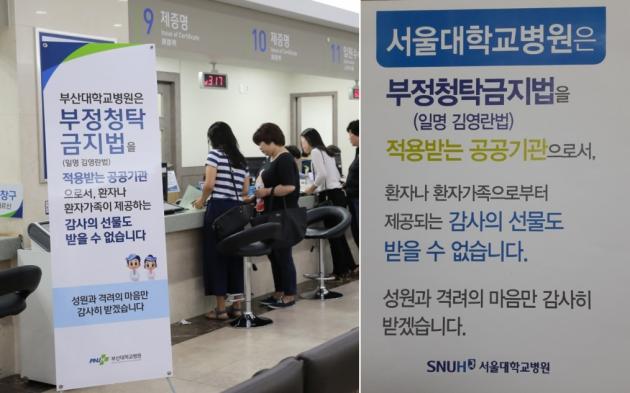Almost a year after the Act on Prohibiting Improper Solicitation and Graft, or “Kim Young-ran Law,” went into effect, many changes have occurred in the medical community. Above all, solicitations to move up the orders of patient treatments and surgeries disappeared.
“The biggest change after the implementation of the Kim Young-ran Law is the decrease in solicitations for treatments or surgery. There still are some solicitations, but their number has sharply fallen, and most doctors reject them because there are good reasons,” said an official at a university hospital. “I feel more comfortable to work because of the decrease in solicitations and ‘cleaner’ hospital culture.”
Even before the implementation of the act, hospitals made various efforts, including the provision of lectures and handbooks to explain the new law, which seems to have worked, he added.
Hospitals have become far more cautious in dealing with pharmaceutical companies. It is because people working for the university or public hospitals face limitations to dining and exchanging gifts with others.
“I am avoiding meeting people from pharmaceutical companies not to cause unnecessary misunderstanding,” said a professor at a university hospital. “I don’t even attend dinners or product launching events. There is even a joke that share prices of drugmakers have risen because they have lots of surplus funds.”

Medical residents are also feeling the changes caused by the Kim Young-ran law. They reduced unnecessary meetings with people at drugmakers and didn’t get gifts from patients.
“In the past, there were many unscheduled meetings, but now I have only to participate in officially reported meetings so that I can save my time,” said a medical resident. “Before the Kim Young-ran law, most patients gave gifts or gift cards to residents, but that has disappeared. There are many positive effects after the implementation of the act in our society. I hope the law continues to be in place.”
Some others said they agreed on the purpose of the law but voiced the need to improve it. Most urgent is lifting the ceiling on lecture fees, they said.
The enforcement ordinance of the law puts the upper limit on fees paid to outside lecturers. It sets the caps at 500,000 won ($442) an hour for cabinet ministers, 400,000 won for vice ministers, 300,000 won for officials at the G-4 level or higher, and 200,000 won for those at the G-5 level or lower. If the time exceeds an hour, one-half of the upper limit money can be added. However, journalists and private school teachers can receive up to 1 million won per hour.
“Professors at private university hospitals receive same fees, but those at national university hospital don’t receive the same pay, resulting in the problem of discrimination,” said a national university hospital professor. “I feel it regrettable that the law doesn’t recognize the value of intellectual labor. Personally, I agree on the good points of the act and hope to see it implemented for long, but details need to be revised.”
Some said they feel it uncomfortable to make mandatory reports to hospitals before and after they deliver lectures outside of the hospitals.
“It doesn’t make sense for professors to report about giving lectures as if they were potential criminals or something,” a professor said. “We have to make reports a day after an event. If we don’t report on time, it is illegal. It 's hard to report because we don’t know in advance how much fee we get. Nor can we ask the amount given our culture.”
Others pointed to the problem of limiting financial support for academic conferences.
“Income from academic events has fallen because there is a limit to setting up PR booths by drugmakers,” said an official at an academy. “The Kim Young-ran law is designed to prevent bribery or ask illegal solicitation, but our academy has nothing to do with such improper activities. It’s regrettable the law has shriveled normal scholastic activities, too.”

